- 1Center for Monsoon System Research, Institute of Atmospheric Physics, Chinese Academy of Sciences, Beijing, China
- 2School of Earth Sciences, Zhejiang University, Hangzhou, China
- 3Southern Marine Science and Engineering, Guangdong Laboratory (Zhuhai), Zhuhai, China
- 4Plateau Atmosphere and Environment Key Laboratory of Sichuan Province, School of Atmospheric Sciences, Chengdu University of Information Technology, Chengdu, China
- 5Key Laboratory of Arid Climate Resource and Environment of Gansu Province, Research and Development Center of Earth System Model, College of Atmospheric Sciences, Lanzhou University, Lanzhou, China
- 6Beijing Weather Forecast Center, Beijing, China
In recent years, some studies emphasized the influence of western Tibetan Plateau summer snow on the East Asian summer precipitation. With the temperature rise in the past decades, the snow cover over the western Tibetan Plateau in summer has significantly decreased. This raises the question whether the impact of the Tibetan Plateau snow has changed. The present study identifies a prominent change in the influence of the western Tibetan Plateau snow cover on the East Asian summer precipitation. Before the early 2000’s, positive precipitation anomalies extend from the southeastern Tibetan Plateau through the Yangtze River to Japan and Korea and negative anomalies cover southeast China corresponding to more Tibetan Plateau snow cover. After the early 2000’s, with the reduction of snow cover variability, below-normal and above-normal summer precipitation occurs over northern China-Mongolia and northeast Asia, respectively, corresponding to more Tibetan Plateau snow cover. The change in the influence of the Tibetan Plateau snow on the East Asian summer precipitation is associated with an obvious change in the atmospheric circulation anomaly pattern. Before the early 2000’s, the wind anomalies display a south-north contrast pattern with anomalous convergence along the Yangtze River. After the early 2000’s, an anomalous cyclone occupies Northeast China with anomalous southerlies and northerlies over northeast Asia and northern China, respectively. The Tibetan Plateau snow cover variation after the early 2000’s is associated with the northeast Indian summer precipitation. The model experiments confirm that the weakened influence of summer western Tibetan Plateau snow cover on the East Asian atmospheric circulation and precipitation with the reduced snow cover anomalies.
Introduction
Snow is an important component in the global energy budget and hydrological cycle (Barnett et al., 1989; Yasunari et al., 1991). The snow variations have a significant influence on the climate system and modulate regional weather and climate (Cohen and Rind, 1991; Brown, 2000; Wu and Kirtman, 2007; Ding et al., 2009; Wu et al., 2014; Schlögl et al., 2018; Wang et al., 2019; Zhang et al., 2020). On the other hand, the change of snow is affected by the atmosphere, especially the air temperature (Karl et al., 1993; Wang et al., 2018a). With rapid global warming in the past decades, the snow cover has declined over most areas of Earth (Bormann et al., 2018).
Due to the high altitude, the average air temperature over the Tibetan Plateau is lower than the surrounding regions. Most areas of the Tibetan Plateau are covered by snow in cold seasons, and there are still snow covered regions with higher altitudes in the summer, especially the western and southern parts of the Tibetan Plateau (Wang et al., 2018a). Since Blanford. (1884) found the relationship between northwest Indian summer precipitation and the winter-spring snow on the Himalayas, a large number of studies have analyzed the influence of the Tibetan Plateau snow on regional weather and climate (Chen and Wu, 2000; Lin and Wu, 2011; Xiao and Duan, 2016; Wang et al., 2017; Li et al., 2018; Qian et al., 2019; Wang et al., 2020; You et al., 2020; Jia et al., 2021). These studies found the impact of cold season snow over the Tibetan Plateau on East Asian, Indian, Eurasian, and North Americna climate variability. However, due to lack of effective long-term observation snow data, the effect of summer snow over the Tibetan Plateau on climate has been neglected for a long time.
In recent years, the high-resolution long-term snow cover data over the whole Tibetan Plateau have been gradually accumulated (Estilow et al., 2015). The influence of summer snow cover on regional climate has been emphasized by some studies. For instance, the Tibetan Plateau snow anomalies modulate the East Asian summer precipitation (Wu et al., 2012; Liu et al., 2014; Wang et al., 2018b) and influence Eurasian heatwave frequency (Wu et al., 2016). However, the Tibetan Plateau has experienced an obvious temperature rise in the past few decades (Wang et al., 2008; Zhong et al., 2019), and the summer snow cover has decreased largely over the Tibetan Plateau (Wang et al., 2018a). Under the background of the rapid decrease of summer snow cover over the Tibetan Plateau, whether the relationship between the Tibetan Plateau snow cover and East Asia summer precipitation variations has changed in the past decades is a problem worthy of study. This has important implication as the changes of summer precipitation over East Asia have an important impact on the region (Wang et al., 2001; Wu and Wang 2002).
Our analysis has identified an obvious change in the relationship between the summer Tibetan Plateau snow cover and East Asian precipitation. The present study presents evidence for the change in the relationship and explores the plausible reasons of the change. The rest of this study is organized as follows. We describe data and methods in section 2. In section 3, we present the change in the relationship between the western Tibetan Plateau summer snow cover and East Asian summer precipitation. In section 4, we analyze the effect of northeast Indian summer precipitation on the relationship between the snow cover and East Asian precipitation in the early 2000s. The summary and discussion are provided in section 5.
Data and Methods
This study used the Northern Hemisphere snow cover data of version 4 (Brodzik and Armstrong, 2013), which spans the time period from October 1966 to December 2020. The present analysis only uses the data for the period 1973—2020 as the snow cover data before 1973 is less reliable. The data were acquired from the National Snow and Ice Data Center (NSIDC) (https://nsidc.org/data/NSIDC-0046/versions/4). We converted the weekly EASE-Grid 2.0 projection at a 25-km spatial resolution data to monthly mean on regular 1 × 1 grids.
The monthly precipitation was obtained from the University of East Anglia Climate Research Unit (CRU) of version 4.05 (http://www.cru.uea.ac.uk/data/) (Harris et al., 2014). The CRU data have a spatial resolution of 0.5 × 0.5 and are available from 1901 to 2020.
The NCEP/NCAR reanalysis 1 data (Kalnay et al., 1996) provide monthly mean geopotential heights and winds at pressure levels from 1948 to the present. The pressure level variables are on regular 2.5 × 2.5 grids. The NCEP-DOE reanalysis variables were obtained from the NOAA/OAR/ESRL Physical Science Department (https://psl.noaa.gov/data/).
This study focused on the relationship between the western Tibetan Plateau summer snow cover and the East Asian summer precipitation on interannual time scales. Summer refers to June-July-August (JJA) in the present study. The component of the interannual signal was obtained by a 9-years high pass Gaussian filter. Linear regression, partial regression, sliding correlation, and correlation analysis were used in the study. The significance level of regression and correlation analysis was estimated using the Student’s t-test.
The Community Atmospheric Model version 5.0 (CAM5), the atmospheric component of the Community Earth System Model (CESM), is adopted in this study to examine the response of atmospheric circulation and precipitation to albedo changes caused by snow cover. The CAM5 is developed by the National Center for Atmospheric Research (Neale et al., 2010) Atmosphere Model Working Group. The model has a 1.9 × 2.5 finite volume grid and 31 vertical levels.
Results
Changes in the Relationship Between Snow Cover and Precipitation
The snow cover over the Tibetan Plateau in summer is mainly located in the high altitude region of the western and southern parts, and the values of snow cover in the western part are larger than in the southern part (Figure 1A, shaded). The interannual variations of snow cover in the western part are more prominent than in the southern part (Figure 1A, contour). The large variation of the western Tibetan Plateau snow cover has an obvious influence on East Asian precipitation in summer (Wang et al., 2018b). We use the area mean of interannual western (Domain: 30°N-43°N, 69°E-80°E) snow cover anomalies as an index (Figure 1C, blue line) to reexamine the above relationship. Corresponding to more snow cover in the western Tibetan Plateau, positive precipitation anomalies are observed in central China, Japan, and Korean Peninsula, and negative anomalies exist in southeast China, north China, and the northeastern part of India (Figure 1B).
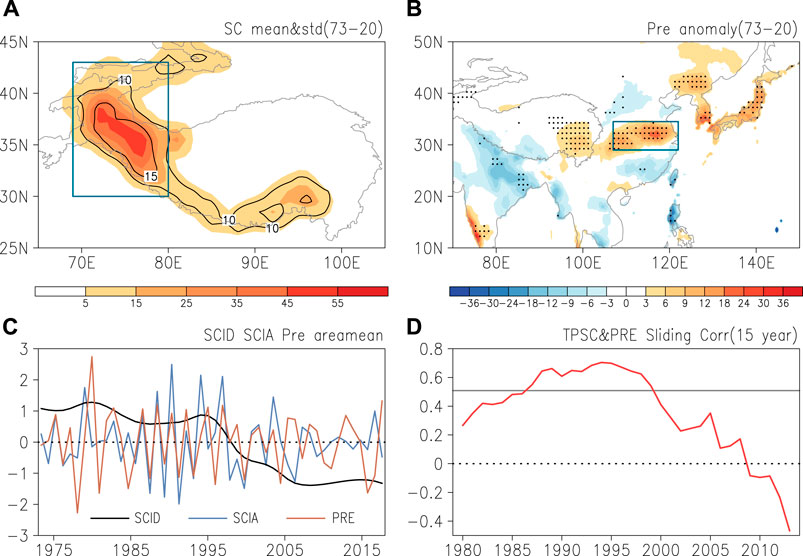
FIGURE 1. (A) Climatological mean (shading, %) and interannual standard deviation (contour, %) of snow cover (SC) in summer over the Tibetan Plateau for the period 1973—2020. (B) Anomalies of summer precipitation (Pre) (mm/month) obtained by linear regression against the western Tibetan Plateau summer snow cover index for the period 1973—2020. (C) Standardized area-mean interannual (SCIA) (blue line) and interdecadal (SCID) (black line) summer snow cover anomalies over the western Tibetan Plateau, and interannual East Asian summer precipitation (Pre) (brown line) anomalies for the period 1973—2020. (D) Sliding correlation coefficients between the interannual western Tibetan Plateau summer snow cover index (TPSC) and interannual East Asian summer precipitation index (Pre) with a 15-years moving window for the period 1973—2020. The dotted regions in (B) denote anomalies significant at the 95% confidence level. The gray line in (D) denotes the 15-years sliding correlation coefficient significant at the 95% confidence level. The box covered area in (A) denotes the domain (30°N-43°N, 69°E-80°E) of western Tibetan Plateau, same in other figures. The box covered area in (B) denotes the domain (29°N-34.5°N, 107°E-122°E) used to calculate the East Asian summer precipitation index. Curves in (A) and (B) denote the elevation of 3000 m over the Tibetan Plateau region, same in other figures.
With the significant warming, the summer snow cover over the western Plateau displays an obvious decrease in the past decades (Figure 1C, black line). Would this affect the relationship between western Plateau summer snow cover and East Asian summer precipitation? To address this issue, we use the area mean central China (Domain: 29°N-34.5°N, 107°E-122°E) interannual precipitation anomalies as an index to represent the East Asian summer precipitation (Figure 1C, brown line). We calculate the sliding correlation between the snow cover index and the precipitation index. Their correlation coefficient is large before the middle 1990’s, but experiences a continue decrease after that (Figure 1D). The result indicates that the relationship between two indexes is unstable.
To illustrate the change in the relationship between the western Tibetan Plateau snow cover and the East Asian precipitation in summer, we divide the 1973—2020 period into two sub-periods (1973—2001 and 2001—2020) to analyze the relationship, respectively. The selection of the year 2001/2002 as the changing point is based on the following two considerations. One is the change of standardized western Plateau snow cover interdecadal anomalies from positive to negative (Figure 1C, black line). The other is the large drop of the sliding correlation between the two indexes (Figure 1D).
For the period 1973—2001, the snow cover distribution and interannual variation are similar to the whole period, but the values are obviously larger than the whole period (Figures 1A, Figure 2A). Corresponding to more snow cover in the western Tibetan Plateau, the distribution of precipitation anomalies is also similar to the whole period, but with a larger value (Figures 1B, Figures 2C). At the upper level, cyclonic anomalies are observed over the western Tibetan Plateau, anticyclonic anomalies extend from the eastern part of the Tibetan Plateau to the subtropical western North Pacific, and cyclonic anomalies are distributed from northeast China to east of Japan (Figure 3A). The circulation anomalies at the lower level (Figure 3C) are similar to those at upper level over East Asia and western North Pacific, indicative of a barotropic vertical structure. Anomalous wind convergence extends from the eastern Tibetan Plateau to east Japan (Figure 3C), corresponding to positive precipitation anomalies (Figure 2C).
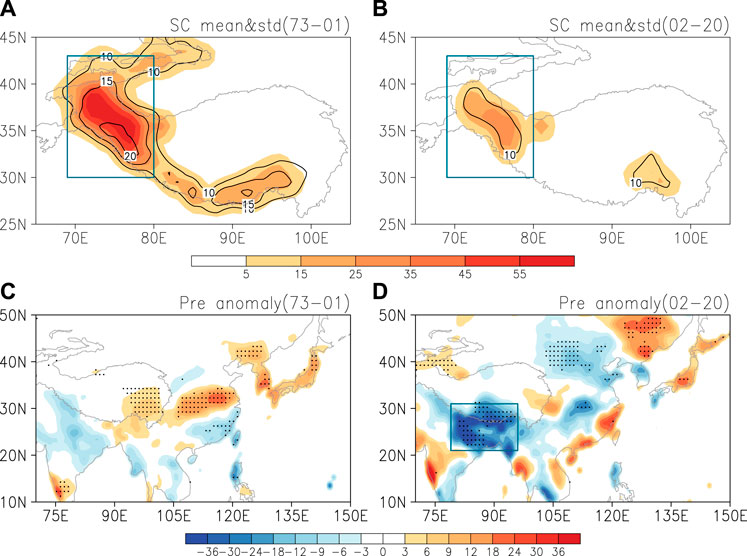
FIGURE 2. Climatological mean (shading, %) and interannual standard deviation (contour, %) of snow cover over the Tibetan Plateau for the period (A) 1973—2001 and (B) 2002—2020. Anomalies of summer precipitation (Pre) (mm/month) obtained by linear regression against the western Tibetan Plateau summer snow cover index for the period (A) 1973—2001 and (B) 2002—2020. The dotted regions in (C) and (D) denote anomalies significant at the 95% confidence level. The box covered area in (D) denotes the domain (21°N-31°N, 79°E-96°E) of northeast Indian region.
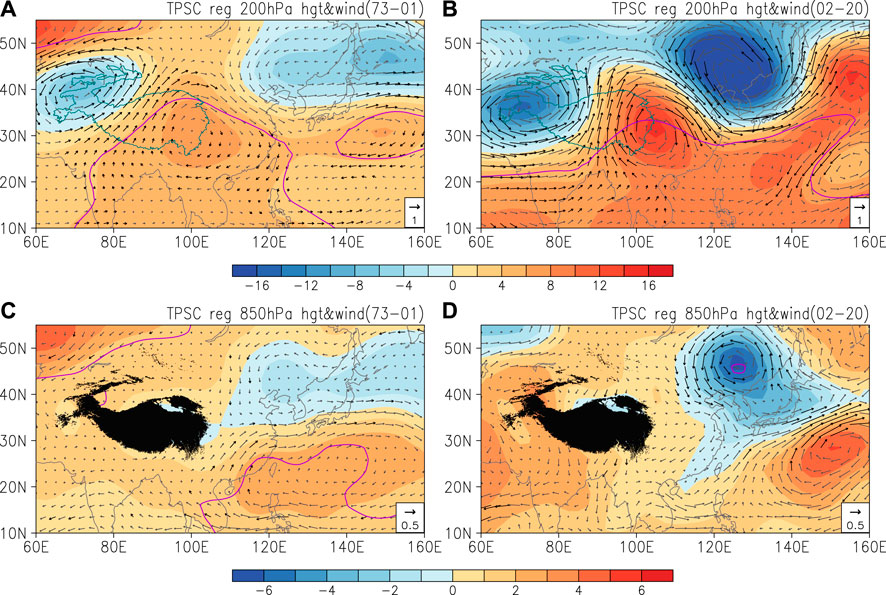
FIGURE 3. Anomalies of (A, B) 200 hPa and (C, D) 850 hPa geopotential height (hgt) (shading, gpm) and wind (vector, m/s) in summer obtained by linear regression against the western Tibetan Plateau summer snow cover index for the period (A, C) 1973—2001 and (B, D) 2002—2020. The scale for winds is shown at the bottom-right corner. The black vectors denote wind anomalies significant at the 95% confidence level. The purple contours denote geopotential height anomalies significant at the 95% confidence level.
For the period 2002—2020, the area of snow cover anomalies shrinks and the anomalous value declines, mainly located in part of western and southeast Plateau, and its interannual variation also decreases obviously (Figure 2B). Corresponding to positive snow cover anomalies in the western Tibetan Plateau, precipitation anomalies are completely different from those in the previous period. Negative precipitation anomalies are distributed in northern China-Mongolia and in northeast India, and positive anomalies are distributed in southeast coast of China and part of northeast Asia (Figure 2D). At upper level, cyclonic anomalies are distributed over the western Plateau and northeast Asia regions, and anticyclonic anomalies are observed over the eastern Plateau to central China and eastern Japan (Figure 3B). At the lower level, cyclonic anomalies are distributed over the northeast Asia region (Figure 3D). The southerly and northerly wind anomalies over the northeast and southwest part of the anomalous cyclone correspond to positive and negative precipitation anomalies, respectively (Figures 2D, Figures 3D). Anticyclonic anomalies are seen over the subtropical western Pacific with a northwest shift of the location with the altitude (Figures 3B,D).
Influence of Northeast Indian Precipitation Anomalies
During the period 2002—2020, while the snow cover anomalies over the Tibetan Plateau are reduced obviously, atmospheric circulation and precipitation anomalies over East Asia have increased, which seems to be a puzzle. At the same period, obvious precipitation anomalies are observed over northeast India. Previous studies indicated that the north Indian summer precipitation anomalies have a significant effect on East Asian summer precipitation variations (Wu 2002; Wei et al., 2015; Wu 2017). Would the northeast Indian precipitation anomalies have an effect on the Tibetan Plateau snow cover and East Asian precipitation during the period 2002—2020? We perform the following analysis to answer this question.
First, we analyzed correlations between the Tibetan Plateau summer snow cover index and northeast Indian summer precipitation index (Figure 2D, box covered area, domain: 21°N-31°N, 79°E-96°E). The correlation coefficient is −0.12 and −0.56, respectively, in the period 1973—2001 and 2002—2020. The correlation coefficient in the second period is significant at the 95% confidence level. The sliding correlation shows that the negative correlation between the two indices continues to increase after the eary 2000’s (Figure 4). The result confirms that the Tibetan Plateau snow cover and the northeast Indian precipitation in summer have a significant negative correlation for the second period.
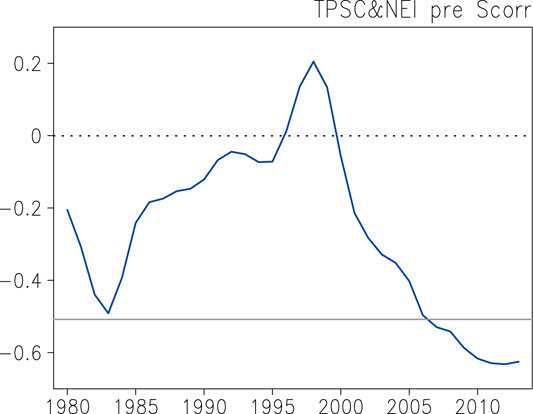
FIGURE 4. Sliding correlation coefficient between the interannual western Tibetan Plateau summer snow cover index (TPSC) and interannual northeast Indian summer precipitation index (NEI pre) with a 15-years moving window for the period 1973—2020. The gray line denotes the 15-years sliding correlation coefficient significant at the 95% confidence level.
To illustrate whether the northeast Indian precipitation anomalies influence the East Asian precipitation and the western Tibetan Plateau snow cover changes for the period 2002—2020, we regressed the geopotential height and wind anomalies at 200 hPa and 850 hPa, precipitation and snow cover anomalies against the northeast Indian summer precipitation index. The above-normal precipitation over the northeast India is accompanied by anomalous heating that induces an anomalous lower-level cyclone over the Arabian Sea and western India and an anomalous upper-level anticyclone to the west of the Tibetan Plateau (Figures 5A,B), which is consistent with Rodwell and Hoskins. (1996). The perturbed atmosphere in turn induces downstream atmospheric circulation anomalies extending to East Asia. Corresponding to positive northeastern Indian precipitation anomalies, anticyclonic anomalies are observed over northeast Asia, and cyclonic anomalies are distributed over the eastern Tibetan Plateau and east of Japan at the upper level (Figure 5A). At the lower level, there are anticyclonic anomalies off the coast of eastern China and over northeast Asia, and cyclonic anomalies exist east of Japan (Figure 5B). The above circulation anomalies are very similar to those obtained by regression against the western Tibetan Plateau snow cover index except for opposite anomalies (Figures 3B,D and Figures 5A,B). The precipitation anomalies also have similar (opposite) features (Figure 2D and Figure 5C). Above normal northeast Indian precipitation is also accompanied by reduced snow cover over the western Tibetan Plateau (figure not shown). The results further illustrate the negative relationship between the Tibetan Plateau snow cover and northeast Indian precipitation.
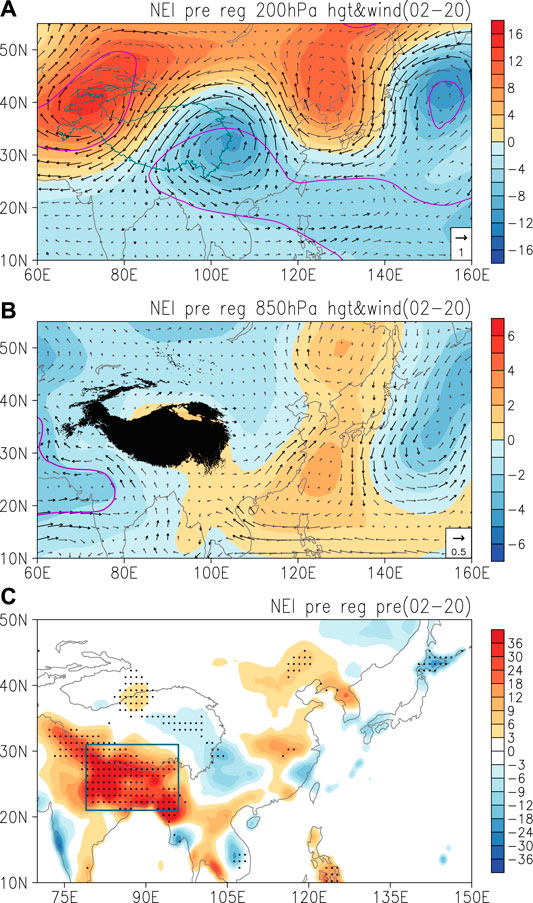
FIGURE 5. Anomalies of (A) 200 hPa and (B) 850 hPa geopotential height (hgt) (shading, gpm) and wind (vector, m/s) in summer obtained by linear regression against the northeast Indian summer precipitation index for the period 2002—2020. (C) Anomalies of summer precipitation (pre) (mm/month) obtained by linear regression against the northeast Indian summer precipitation index for the period 2002—2020. The scale for winds is shown at the bottom-right corner. The black vectors in (A, B) denote wind anomalies significant at the 95% confidence level. The purple contours in (A, B) denote geopotential height anomalies significant at the 95% confidence level. The dotted regions in (C) denote precipitation anomalies significant at the 95% confidence level.
To examine the effect of northeast Indian precipitation anomalies in the change of the relationship between the western Tibetan Plateau summer snow cover and East Asian precipitation around the early 2000’s, we perform a partial regression analysis. After removing the northeast Indian precipitation signal, corresponding to positive snow cover anomalies, weak cyclonic anomalies exist over the southwestern Tibetan Plateau, cyclonic anomalies are located over Northeast China, positive geopotential heights anomalies extend southern China to subtropical western North Pacific at the upper level (Figure 6A). The distribution of circulation anomalies at the upper-level displays differences from the pattern against the snow cover index in the second period (Figures 3A, Figures 6B), but somewhat similarity to the pattern against the snow cover index in the first period with lower significance of circulation anomalies (Figures 3A, Figures 6A). At the lower level, the circulation anomalies over East Asia are also similar to the pattern against the snow cover index in the first period (Figures 3C, Figures 6C). The above analysis implies that when the northeast Indian precipitation signal is removed the influence of the western Tibetan Plateau snow cover anomalies on the East Asian atmospheric circulation in the second period is similar to the first period, but the influence is weakened. However, after removing the northeast Indian precipitation signal, the precipitation anomalies over eastern China and northeast Asia are similar to those when the signal is not removed, but the magnitude of precipitation anomalies decreases (Figures 2D, Figures 7A). When the snow cover signal is removed, the circulation anomalies at both the upper and lower levels are similar to those when the signal is not removed, but the level of significance decreases (Figures 5A,B and Figures 6B,D), and the precipitation anomalies are weak over East Asia (Figure 7B). From the above analysis, we can conclude that with the snow cover variation reduced in the second period, the influence of summer western Tibetan Plateau snow cover on the East Asian atmospheric circulation and precipitation becomes weaker, the snow cover anomalies are influenced by the precipitation changes over the northeast India, and especially the atmospheric circulation anomalies which are related to the Tibetan Plateau snow cover anomalies are mainly affected by the northeast Indian precipitation change.
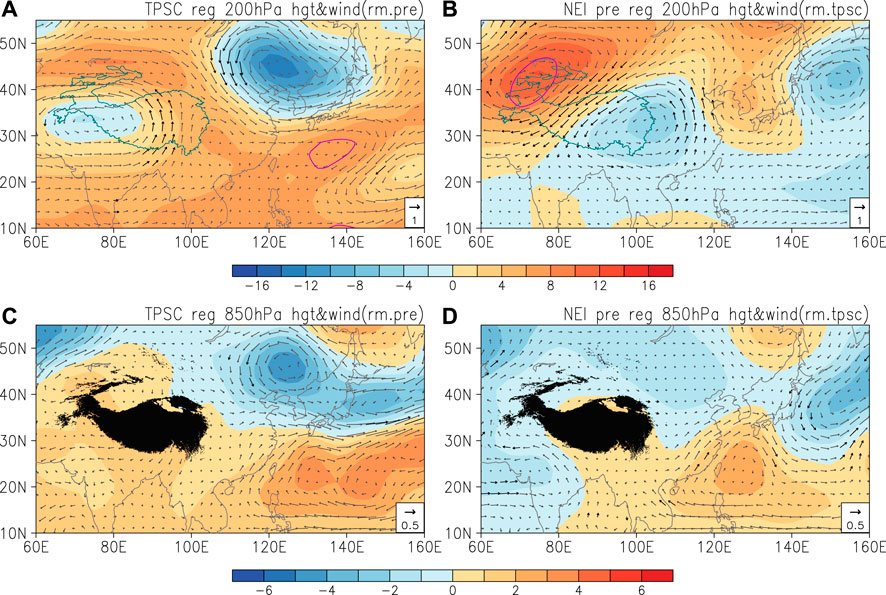
FIGURE 6. Anomalies of (A, B) 200 hPa and (C, D) 850 hPa geopotential height (hgt) shading, gpm) and wind (vector, m/s) in summer obtained by linear regression against the (A, C) western Tibetan Plateau summer snow cover index and (B, D) northeast Indian summer precipitation index for the period 2002—2020 with the (A, C) northeast Indian summer precipitation signal and (B, D) western Tibetan Plateau summer snow cover signal removed. The scale for winds is shown at the bottom-right corner. The black vectors denote wind anomalies significant at the 95% confidence level. The purple contours denote geopotential height anomalies significant at the 95% confidence level.
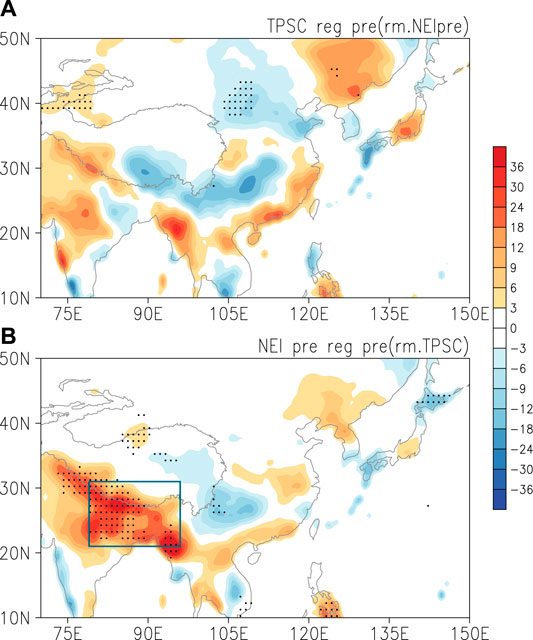
FIGURE 7. Anomalies of summer precipitation (pre) (mm/month) obtained by linear regression against the (A) western Tibetan Plateau summer snow cover index and (B) northeast Indian summer precipitation index for the period 2002—2020 with the (A) northeast Indian summer precipitation signal and (B) western Tibetan Plateau summer snow cover signal removed. The dotted regions in (A) and (B) denote anomalies significant at the 95% confidence level.
Model Simulation for the Different Snow Cover Status
To verify the influence of more and less snow cover anomalies over the western Tibetan Plateau on East Asian precipitation changes, we perform numerical experiments using CAM5. One control run and two forcing runs are conducted in the study. In the control run, which serves as a reference for the forcing runs, climatological monthly SST for the period 1981—2010 is specified in the global oceans and the surface albedo is calculated by the model itself. In the forcing runs, the surface albedo is calculated by the model itself except for the western Tibetan Plateau in summer. Over the western Tibetan Plateau in summer, when the albedo is lower than 0.8, it is reset to a fixed value of 0.8 in the high albedo forcing run to represent features of more snow over the western Tibetan Plateau (Figure 8A), and when the albedo is higher than 0.3, it is reset to a fixed value of 0.3 in the low albedo forcing run to represent features of less snow over the western Tibetan Plateau (Figure 8B). The albedo over 0.8 is nearly fresh snow surface albedo, and less than 0.3 is nearly dry bare ground surface albedo (Cohen and Rind, 1991). In all the experiments, the model is integrated for 15 years. The differences of geopotential height, wind, and total precipitation in summer between forcing runs and control run averaged for the last 14 years represent the model response to more and less snow over the western Tibetan Plateau.
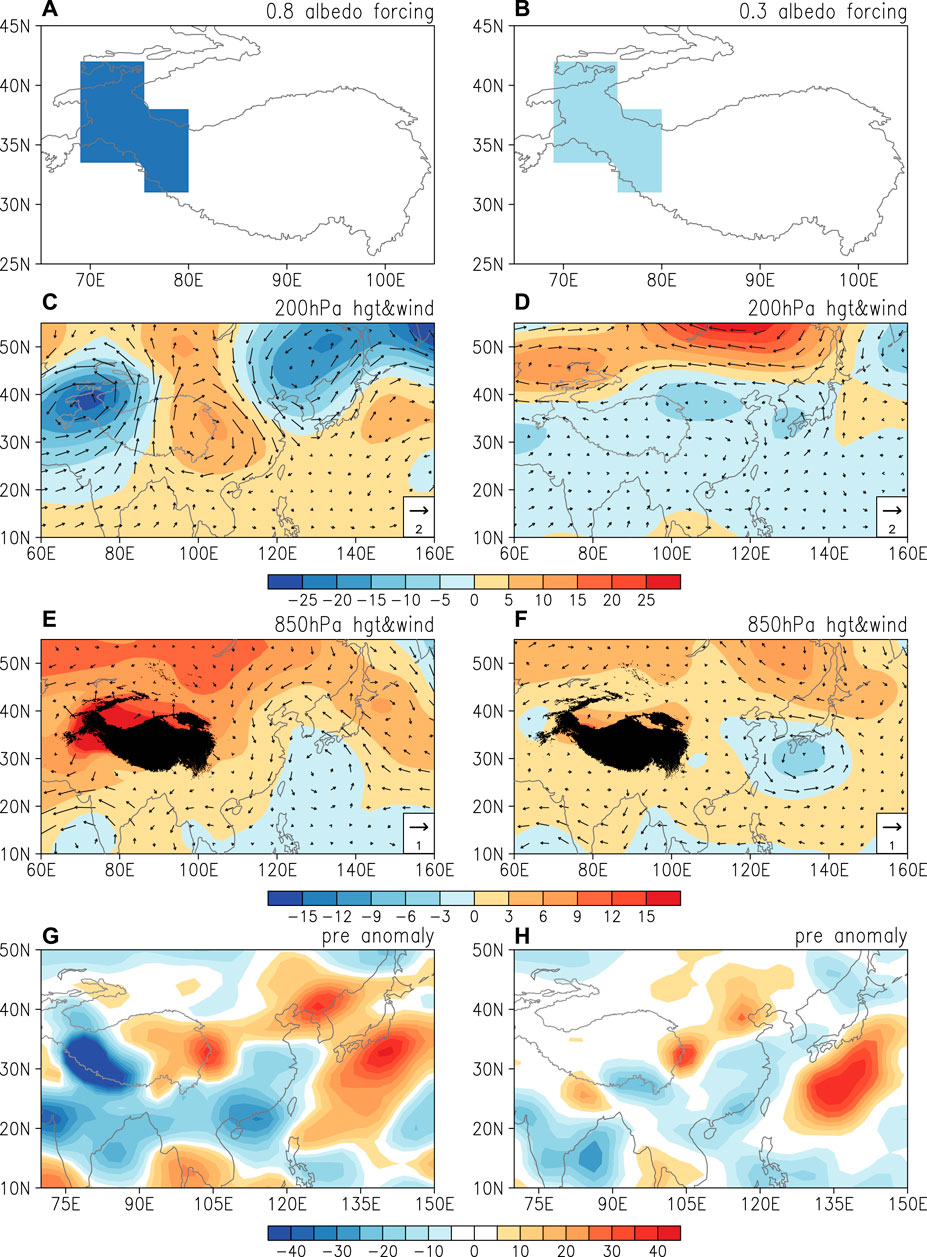
FIGURE 8. Model (A) higher and (B) lower albedo forcing pattern. The model response of (C, D) 200hPa and (E, F) 850hPa geopotential height (hgt) (shading, gpm) and wind (vector, m/s) and (G, H) precipitation (pre) (mm/month) to (C, E, G) higher and (D, F, H) lower albedo forcing. The scale for winds in (C–F) is shown at the bottom-right corner.
In the higher albedo forcing run, at the upper level, cyclonic anomalies exist over the western Plateau and northeast Asian regions, and anticyclonic anomalies are observed over the eastern Plateau region (Figure 8C). The pattern of circulation anomalies is similar to that against the snow cover index for the period 1973—2001 (Figures 3A, Figure 8C). At the lower level, positive geopotential height anomalies are distributed north of the Plateau and over eastern Japan (Figure 8E). The precipitation anomalies display a spatial pattern similar to the observations, but the positive anomalies over East Asia shift northward compared to the observations (Figures 2C, Figure 8G). In the lower albedo forcing run, both the atmospheric circulation and precipitation anomalies are weaker than those in the higher albedo forcing. The upper-level circulation response at the mid- and low-latitude is weak, and positive geopotential height anomalies are distributed north and northeast of the Tibetan Plateau (Figure 8D). At the lower level, weak positive geopotential height anomalies exist in most areas of the continent, and cyclonic anomalies are located off the east coast of China (Figure 8F). Weak positive precipitation anomalies are distributed over the eastern Plateau and North China, and negative precipitation anomalies extend from southern to eastern China (Figure 8H). The model results further illustrate that after the snow cover is reduced over the western Tibetan Plateau, its influence on the atmospheric circulation and precipitation over East Asia is also weakened.
Summary and Discussions
The snow cover over the Tibetan Plateau has an important influence on regional and global climate. Most of the previous studies mainly concerned the impacts of cold season snow anomalies. The effect of summer snow cover anomalies over the Tibetan Plateau has been neglected. In recent years, some papers emphasized the effects of summer Tibetan Plateau snow cover changes on regional climate, especially on the East Asian summer precipitation. With the significant warming over the Tibetan Plateau, the snow cover over the Plateau has an obvious decreasing trend, accompanied by a reduced variability. The present study addresses the question whether the influence of the Tibetan Plateau snow cover changes on the East Asian precipitation has changed with the snow decrease by conducting the statistical analysis and model simulation.
The snow cover over the Tibetan Plateau in summer has an obvious connection with the summer precipitation over East Asia. However, their relationship has a significant decrease in the past decades from the obvious positive correlation before the early 2000s. Then, we divide the 1973—2020 period into two sub-periods, 1973—2001 and 2002—2020, to analyze the changes of influence of more and less snow conditions over the western Tibetan Plateau on East Asian summer precipitation.
In the first period, positive snow cover anomalies over the western Tibetan Plateau induce cyclonic anomalies over the western Tibetan Plateau and northeast Asia to eastern Japan, and anticyclonic anomalies over the eastern Tibetan Plateau to the subtropical western North Pacific at the upper level, similar to the previous study (Wang et al., 2018b). The circulation anomalies have a barotropic vertical structure over East Asia. The circulation anomalies cause positive precipitation anomalies from the eastern Tibetan Plateau through the Yangtze River to Japan, and negative precipitation anomalies over southern China.
In the second period, with the snow cover decrease over the western Tibetan Plateau, the variability of snow cover is also reduced. However, corresponding to positive snow cover anomalies, more significant cyclonic anomalies are observed over the western Tibetan Plateau and northeast Asian regions, and anticyclonic anomalies exist over the eastern Tibetan Plateau and eastern Japan at the upper level. The barotropic vertical structure is observed over East Asia region as well. The negative precipitation anomalies are distributed over northern China-Mongolia and northeast India, positive anomalies are observed over the coastal area of southeast China and part of northeast Asia. The precipitation anomalies over northeast India are very significant.
Our analysis reveals a significant negative relationship between the snow cover over the western Tibetan Plateau and northeast Indian precipitation in the second period. Corresponding to positive northeast Indian precipitation anomalies, the circulation anomalies are very similar to those against the snow cover index. Partial regression analysis indicates that the influences of the Tibetan Plateau snow cover anomalies on atmospheric circulation over East Asia are largely modulated by the northeast Indian summer precipitation changes.
The CAM5 experiments verify the observational results. With the higher albedo forcing, the response of upper-level atmospheric circulation and precipitation over East Asia is similar to the observations related to the snow cover index in the first period. With the lower albedo forcing, there is a significant reduction of atmospheric circulation and precipitation response over East Asia compared with the higher albedo forcing. So, the model simulation further illustrates the change in the influence of the western Tibetan Plateau snow cover on the East Asian precipitation following the decrease of snow cover under global warming.
The present analysis revealed that the influence of the summer western Tibetan Plateau snow cover on East Asian atmospheric circulation and precipitation changes depends upon the magnitude of snow cover variability. Reduced snow cover may be accompanied by a different atmospheric circulation and precipitation response over East Asia, resulting in changes in the relationship between the Tibetan Plateau snow cover and East Asian summer climate. This indicates an effect of global warming on the Tibetan Plateau snow impacts.
The East Asian atmospheric circulation changes subject to influences of other factors, e.g., the sea surface temperature (SST) anomalies in the tropical Indo-Pacific region. It is possible that the Tibetan Plateau snow cover-East Asian precipitation relationship may be modulated by the tropical Indo-Pacific SST anomalies. Further investigation is needed to understand the contribution of the SST forcing and its cooperation with the Tibetan Plateau snow effects in the East Asian climate variability.
Data Availability Statement
The original contributions presented in the study are included in the article/Supplementary Material, further inquiries can be directed to the corresponding author.
Author Contributions
Conceptualization: RW, ZW Data curation: ZW Formal analysis: ZW, RW, ZC, LZ, KY, KL, and YY Funding acquisition: RW, ZW Investigation: ZW Methodology: RW, ZW Project Administration: RW, ZW Resources: ZW Supervision: RW Validation: ZW, RW Writing original draft: ZW, RW Writing review and editing: ZW, RW, ZC, LZ, KY, KL, and YY.
Funding
This study is supported by the National Natural Science Foundation of China grants (42105028, 41721004 and 41775080), the China Postdoctoral Science Foundation (2019M660762, and 2020T130640).
Conflict of Interest
The authors declare that the research was conducted in the absence of any commercial or financial relationships that could be construed as a potential conflict of interest.
Publisher’s Note
All claims expressed in this article are solely those of the authors and do not necessarily represent those of their affiliated organizations, or those of the publisher, the editors and the reviewers. Any product that may be evaluated in this article, or claim that may be made by its manufacturer, is not guaranteed or endorsed by the publisher.
References
Barnett, T. P., Dümenil, L., Schlese, U., Roeckner, E., and Latif, M. (1989). The Effect of Eurasian Snow Cover on Regional and Global Climate Variations. J. Atmos. Sci. 46 (5), 661–686. doi:10.1175/1520-0469(1989)046<0661:teoesc>2.0.co;2
Blanford, H. F. (1884). II. On the Connexion of the Himalaya Snowfall with Dry Winds and Seasons of Drought in India. Proc. R. Soc. Lond. 37 (232-234), 3–22. doi:10.1098/rspl.1884.0003
Bormann, K. J., Brown, R. D., Derksen, C., and Painter, T. H. (2018). Estimating Snow-Cover Trends from Space. Nat. Clim Change 8 (11), 924–928. doi:10.1038/s41558-018-0318-3
Brodzik, M., and Armstrong, R., 2013: Northern Hemisphere EASE-Grid 2.0 Weekly Snow Cover and Sea Ice Extent, version 4. National Snow and Ice Data Center, (Accessed on August 21, 2021).
Brown, R. D. (2000). Northern Hemisphere Snow Cover Variability and Change, 1915-97. J. Clim. 13 (13), 2339–2355. doi:10.1175/1520-0442(2000)013<2339:nhscva>2.0.co;2
Chen, L., and Wu, R. (2000). Interannual and Decadal Variations of Snow Cover over Qinghai-Xizang Plateau and Their Relationships to Summer Monsoon Rainfall in China. Adv. Atmos. Sci. 17 (1), 18–30. doi:10.1007/s00376-000-0040-7
Cohen, J., and Rind, D. (1991). The Effect of Snow Cover on the Climate. J. Clim. 4 (7), 689–706. doi:10.1175/1520-0442(1991)004<0689:teosco>2.0.co;2
Ding, Y., Sun, Y., Wang, Z., Zhu, Y., and Song, Y. (2009). Inter-decadal Variation of the Summer Precipitation in China and its Association with Decreasing Asian Summer Monsoon Part II: Possible Causes. Int. J. Climatol. 29 (13), 1926–1944. doi:10.1002/joc.1759
Estilow, T. W., Young, A. H., and Robinson, D. A. (2015). A Long-Term Northern Hemisphere Snow Cover Extent Data Record for Climate Studies and Monitoring. Earth Syst. Sci. Data 7 (1), 137–142. doi:10.5194/essd-7-137-2015
Harris, I., Jones, P. D., Osborn, T. J., and Lister, D. H. (2014). Updated High-Resolution Grids of Monthly Climatic Observations - the CRU TS3.10 Dataset. Int. J. Climatol. 34 (3), 623–642. doi:10.1002/joc.3711
Jia, X., Zhang, C., Wu, R., and Qian, Q. (2021). Influence of Tibetan Plateau Autumn Snow Cover on Interannual Variations in spring Precipitation over Southern China. Clim. Dyn. 56 (3), 767–782. doi:10.1007/s00382-020-05497-8
Kalnay, E., Kanamitsu, M., Kistler, R., Collins, W., Deaven, D., Gandin, L., et al. (1996). The NCEP/NCAR 40-year Reanalysis Project. Bull. Amer. Meteorol. Soc. 77 (3), 437–471. doi:10.1175/1520-0477(1996)077<0437:tnyrp>2.0.co;2
Karl, T. R., Groisman, P. Y., Knight, R. W., and Heim, R. R. (1993). Recent Variations of Snow Cover and Snowfall in North America and Their Relation to Precipitation and Temperature Variations. J. Clim. 6 (7), 1327–1344. doi:10.1175/1520-0442(1993)006<1327:rvosca>2.0.co;2
Li, W., Guo, W., Qiu, B., Xue, Y., Hsu, P. C., and Wei, J. (2018). Influence of Tibetan Plateau Snow Cover on East Asian Atmospheric Circulation at Medium-Range Time Scales. Nat. Commun. 9 (1), 4243–4249. doi:10.1038/s41467-018-06762-5
Lin, H., and Wu, Z. (2011). Contribution of the Autumn Tibetan Plateau Snow Cover to Seasonal Prediction of North American winter Temperature. J. Clim. 24 (11), 2801–2813. doi:10.1175/2010jcli3889.1
Liu, G., Wu, R., Zhang, Y., and Nan, S. (2014). The Summer Snow Cover Anomaly over the Tibetan Plateau and its Association with Simultaneous Precipitation over the Mei-Yu-Baiu Region. Adv. Atmos. Sci. 31 (4), 755–764. doi:10.1007/s00376-013-3183-z
Neale, R. B., Chen, C. C., Gettelman, A., Lauritzen, P. H., Park, S., Williamson, D. L., et al. (2010). Description of the NCAR Community Atmosphere Model (CAM 5.0). NCAR Tech. Note Ncar/tn-486+ STR 1 (1), 1–12.
Qian, Q., Jia, X., and Wu, R. (2019). Changes in the Impact of the Autumn Tibetan Plateau Snow Cover on the Winter Temperature over North America in the Mid‐1990s. J. Geophys. Res. Atmos. 124 (19), 10321–10343. doi:10.1029/2019jd030245
Rodwell, M. J., and Hoskins, B. J. (1996). Monsoons and the Dynamics of Deserts. Q.J R. Met. Soc. 122 (534), 1385–1404. doi:10.1002/qj.49712253408
Schlögl, S., Lehning, M., and Mott, R. (2018). How Are Turbulent Sensible Heat Fluxes and Snow Melt Rates Affected by a Changing Snow Cover Fraction. Front. Earth Sci. 6, 154. doi:10.3389/feart.2018.00154
Wang, B., Bao, Q., Hoskins, B., Wu, G., and Liu, Y. (2008). Tibetan Plateau Warming and Precipitation Changes in East Asia. Geophys. Res. Lett. 35 (14), 1–5. doi:10.1029/2008gl034330
Wang, B., Wu, R., and Lau, K.-M. (2001). Interannual Variability of the Asian Summer Monsoon: Contrasts between the Indian and the Western North Pacific-East Asian Monsoons*. J. Clim. 14 (20), 4073–4090. doi:10.1175/1520-0442(2001)014<4073:ivotas>2.0.co;2
Wang, C., Yang, K., Li, Y., Wu, D., and Bo, Y. (2017). Impacts of Spatiotemporal Anomalies of Tibetan Plateau Snow Cover on Summer Precipitation in Eastern China. J. Clim. 30 (3), 885–903. doi:10.1175/jcli-d-16-0041.1
Wang, M., Jia, X. J., Ge, J. W., and Qian, Q. F. (2019). Changes in the Relationship between the Interannual Variation of Eurasian Snow Cover and spring SAT over Eastern Eurasia. J. Geophys. Res. Atmos. 124 (2), 468–487. doi:10.1029/2018jd029077
Wang, Z., Wu, R., Chen, S., Huang, G., Liu, G., and Zhu, L. (2018b). Influence of Western Tibetan Plateau Summer Snow Cover on East Asian Summer Rainfall. J. Geophys. Res. Atmos. 123 (5), 2371–2386. doi:10.1002/2017jd028016
Wang, Z., Wu, R., Duan, A., and Qu, X. (2020). Influence of Eastern Tibetan Plateau spring Snow Cover on North American Air Temperature and its Interdecadal Change. J. Clim. 33 (12), 5123–5139. doi:10.1175/jcli-d-19-0455.1
Wang, Z., Wu, R., and Huang, G. (2018a). Low-frequency Snow Changes over the Tibetan Plateau. Int. J. Climatol 38 (2), 949–963. doi:10.1002/joc.5221
Wei, W., Zhang, R., Wen, M., Kim, B.-J., and Nam, J.-C. (2015). Interannual Variation of the South Asian High and its Relation with Indian and East Asian Summer Monsoon Rainfall. J. Clim. 28 (7), 2623–2634. doi:10.1175/jcli-d-14-00454.1
Wu, R. (2002). A Mid-latitude Asian Circulation Anomaly Pattern in Boreal Summer and its Connection with the Indian and East Asian Summer Monsoons. Int. J. Climatol. 22 (15), 1879–1895. doi:10.1002/joc.845
Wu, R., and Kirtman, B. P. (2007). Observed Relationship of spring and Summer East Asian Rainfall with winter and spring Eurasian Snow. J. Clim. 20 (7), 1285–1304. doi:10.1175/jcli4068.1
Wu, R., Liu, G., and Ping, Z. (2014). Contrasting Eurasian spring and Summer Climate Anomalies Associated with Western and Eastern Eurasian spring Snow Cover Changes. J. Geophys. Res. Atmospheres 119 (12), 7410–7424. doi:10.1002/2014jd021764
Wu, R. (2017). Relationship between Indian and East Asian Summer Rainfall Variations. Adv. Atmos. Sci. 34 (1), 4–15. doi:10.1007/s00376-016-6216-6
Wu, R., and Wang, B. (2002). A Contrast of the East Asian Summer Monsoon–ENSO Relationship between 1962–77 and 1978–93. J. Clim. 15 (22), 3266–3279. doi:10.1175/1520-0442(2002)015<3266:acotea>2.0.co;2
Wu, Z., Li, J., Jiang, Z., and Ma, T. (2012). Modulation of the Tibetan Plateau Snow Cover on the ENSO Teleconnections: From the East Asian Summer Monsoon Perspective. J. Clim. 25 (7), 2481–2489. doi:10.1175/jcli-d-11-00135.1
Wu, Z., Zhang, P., Chen, H., and Li, Y. (2016). Can the Tibetan Plateau Snow Cover Influence the Interannual Variations of Eurasian Heat Wave Frequency. Clim. Dyn. 46 (11), 3405–3417. doi:10.1007/s00382-015-2775-y
Xiao, Z., and Duan, A. (2016). Impacts of Tibetan Plateau Snow Cover on the Interannual Variability of the East Asian Summer Monsoon. J. Clim. 29 (23), 8495–8514. doi:10.1175/jcli-d-16-0029.1
Yasunari, T., Kitoh, A., and Tokioka, T. (1991). Local and Remote Responses to Excessive Snow Mass over Eurasia Appearing in the Northern spring and Summer Climate. J. Meteorol. Soc. Jpn. Ser. 69 (4), 473–487. doi:10.2151/jmsj1965.69.4_473
You, Q., Wu, T., Shen, L., Pepin, N., Zhang, L., Jiang, Z., and AghaKouchak, A. (2020). Review of Snow Cover Variation over the Tibetan Plateau and its Influence on the Broad Climate System. Earth-Science Rev. 201, 103043. doi:10.1016/j.earscirev.2019.103043
Zhang, R., Sun, C., Zhu, J., Zhang, R., and Li, W. (2020). Increased European Heat Waves in Recent Decades in Response to Shrinking Arctic Sea Ice and Eurasian Snow Cover. NPJ Clim. Atmos. Sci. 3 (1), 1–9. doi:10.1038/s41612-020-0110-8
Keywords: tibetan plateau summer snow cover, east asian summer precipitation, global warming, northeast indian precipitation, weakened influence
Citation: Wang Z, Wu R, Chen Z, Zhu L, Yang K, Liu K and Yang Y (2021) Decreasing Influence of Summer Snow Cover Over the Western Tibetan Plateau on East Asian Precipitation Under Global Warming. Front. Earth Sci. 9:787971. doi: 10.3389/feart.2021.787971
Received: 01 October 2021; Accepted: 08 November 2021;
Published: 25 November 2021.
Edited by:
Bin Yu, Environment and Climate Change (Canada), CanadaCopyright © 2021 Wang, Wu, Chen, Zhu, Yang, Liu and Yang. This is an open-access article distributed under the terms of the Creative Commons Attribution License (CC BY). The use, distribution or reproduction in other forums is permitted, provided the original author(s) and the copyright owner(s) are credited and that the original publication in this journal is cited, in accordance with accepted academic practice. No use, distribution or reproduction is permitted which does not comply with these terms.
*Correspondence: Renguang Wu, cmVuZ3VhbmdAemp1LmVkdS5jbg==
 Zhibiao Wang
Zhibiao Wang Renguang Wu
Renguang Wu Zhang Chen4
Zhang Chen4 Kai Yang
Kai Yang